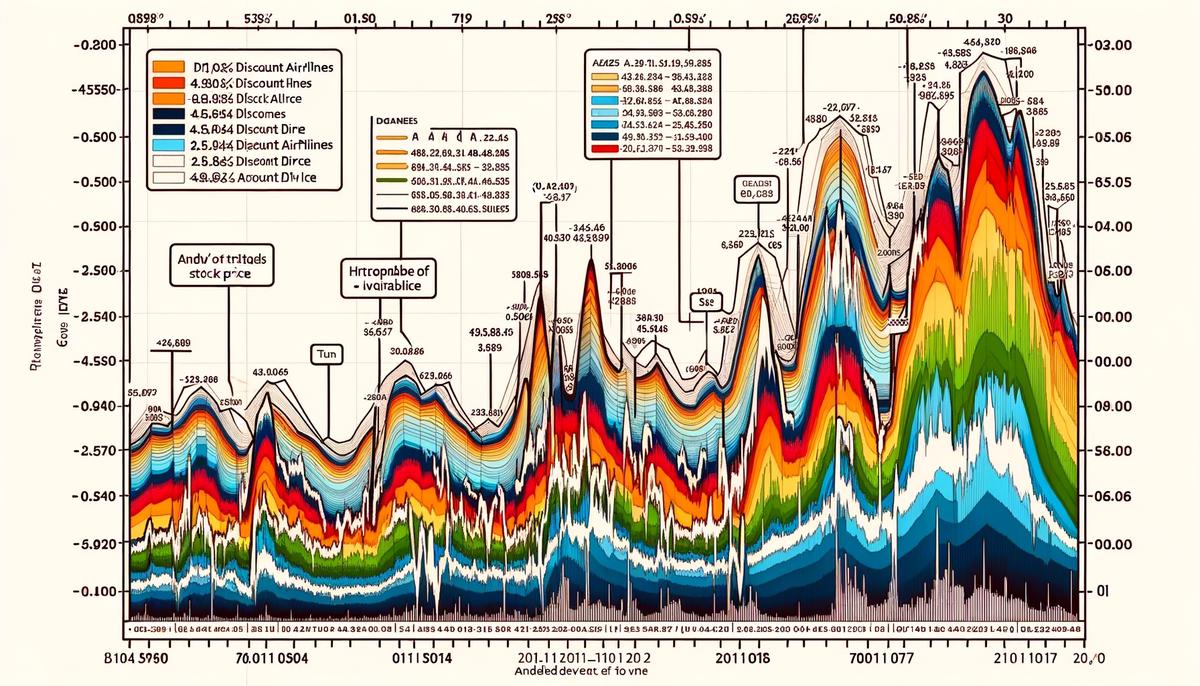Peering into the dynamic realm of discount airline stocks reveals a market that is as turbulent as it is promising. Economic forces, competitive dynamics, and the ever-changing behaviors of travelers are all part of this complex equation, determining the ascent or descent of stock values in the sector. On the financial front, essential metrics such as earnings per share and debt-to-equity ratios serve as navigational instruments, guiding investors through the aerial maze of market predictions and performance histories. As discount carriers strive to chart a profitable course, the impact of global events looms large, with factors like health emergencies and political unrest acting as potential headwinds or tailwinds. Against this backdrop, the stories of individual airlines—some soaring to new heights, others facing rough weather—provide critical lessons in the art of aviation commerce.
Current Landscape of Discount Airline Stocks
Discount Airline Stocks: Navigating the Turbulence in Today’s Market
The performance of discount airline stocks offers a clear glimpse into the aviation industry, especially as the market rides the unpredictable winds of the economy’s current state. Amid fluctuations, these budget-friendly carriers present a mixed bag of outcomes for investors closely watching their portfolios.
In the aerial chess game of finances, discount airlines have been in a steady climb, coming out of the pandemic’s nosedive. The resumption of travel has been a tailwind for the industry, as thrifty travelers, eager to stretch their dollars, opt for the financial ease provided by low-cost carriers. This resurgence in passenger volume has been a booster, propelling stocks skyward.
However, the ascent is not without turbulence. Volatility enters the cockpit, driven by factors such as fluctuating fuel prices, staffing challenges, and changing travel regulations. These variables contribute to periodic chop, resulting in intermittent dips and climbs in stock performance.
Notably, some budget airlines have outperformed their full-service counterparts. Their lean business models, characterized by fewer frills and more focused routes, allows them to navigate the economic air pockets more deftly. Additionally, these carriers typically operate with a cost-efficiency that’s attractive to both passengers and shareholders.
Balancing the equation, market analysts tap into data streams, monitoring demand patterns and industry adaptability. These airlines have rapidly adjusted schedules and capacities, showcasing agility in responding to shifting market convections.
Amidst this backdrop, investor sentiment can feel as clear as a pilot’s view in a storm. The ever-present question looms: are discount airline stocks a ticket to profit or a flight risk? With the market’s current unpredictability, the answer seems to be closely linked to each airline’s ability to maintain altitude in the face of economic headwinds.
As we continue to observe the trajectory, one thing is evident: Discount airlines are maneuvering with calculated precision, banking on their low-cost appeal to draw a crowd. Whether these efforts translate to a steady climb in stock performance remains an unfolding story, watched keenly by market enthusiasts and investors alike.

Fundamental Analysis of Select Discount Airlines
When digging into the nitty-gritty of discount airline stocks, it’s important to have your financial measuring tape at the ready. Just like checking the fuel before a flight, investors must scrutinize certain financial metrics to ensure their stock choices can ascend to promising altitudes. With budget airlines maneuvering through a tight airspace of cost savings and aggressive fare pricing, these metrics become your co-pilot for a sound investment journey.
Earnings per share (EPS), for starters, is the co-captain of meaningful metrics. This figure slices up a company’s profit and serves it on a per-share basis, granting a snapshot of profitability. For savvy investors, an upward trend in EPS may signal that an airline is turning more of its penny-pinching into profit-making.
Yet, the EPS only paints part of the picture. Enter the load factor, a metric as crucial as a pilot’s navigational chart. It measures the percentage of available seating capacity actually filled with paying passengers. High load factors indicate that a discount airline is not just flying; it’s flying full, which is a key indicator that it’s capitalizing on its cost-efficient operations.
Revenue per available seat mile (RASM) and cost per available seat mile (CASM) are like the twin jet engines of financial metrics, powering your understanding of operational efficiency. RASM calculates the revenue made from each seat available per mile, reflecting how well an airline monetizes its capacity. Meanwhile, CASM gives investors insight into the costs incurred for each seat available per mile. Discount airlines thrive by keeping CASM low while attempting to keep RASM as high as market competition allows.
Debt-to-equity ratio also demands attention—it’s the altitude warning signal of the financial metrics. A high ratio suggests the airline is flying on borrowed funds, which can be nerve-wracking in turbulent economic weather. For discount airlines, leveraging some debt can fuel expansion and fleet renewal, but excessive levels can lead to a perilous financial nosedive. Investors seek a balance, indicating the airline is steering clear of a debt storm.
In looking at operational performance, we can’t overlook fuel efficiency. With fuel costs being one of the biggest expenses for airlines, how many miles an airline can fly per gallon impacts the bottom line tremendously. An efficient fleet not only indicates lower operating costs but also reflects environmental consciousness, which can be a magnet for eco-aware passengers and investors alike.
Lastly, passengers might not give two hoots about ancillary revenue, but investors certainly do—it’s the economy class meal that keeps on giving. This metric tallies up the income from extra services beyond ticket sales, such as baggage fees, seat upgrades, and onboard purchases. Discount airlines excel at this game, often outdoing their full-service cousins by turning extras into essential earnings.
A thorough analysis of these financial metrics can lead to a more informed investment strategy regarding discount airline stocks. Together, they form a mosaic of operational health, efficiency, and profitability that helps investors decide whether stocks are cleared for takeoff or grounded for maintenance. Studying these metrics is like performing a pre-flight checklist, essential for a safe and potentially profitable investment journey. Fly through them meticulously and, who knows, your portfolio might just reach cruising altitude.

Impact of Global Events on Discount Airlines
As global events continue to unfold, the landscape for discount airline stocks remains ever shifting and complex. This dynamic environment sees discount carriers tapping into unprecedented strategies to maintain their foothold in a competitive market.
Technology has played a pivotal role in revolutionizing the experience for passengers and operational efficiency for airlines. Budget airlines are implementing innovative software platforms to enhance ticketing systems, customer service, and flight operations. This digital transformation push attempts to capture a tech-savvy demographic while streamlining costs.
Environmental concerns are also taking center stage, with discount airlines feeling the pressure to adopt greener practices. Investment in sustainable aviation fuels, lighter aircraft materials, and electric propulsion systems shows a commitment to reduce carbon footprints. These initiatives are not only seen as ethical moves but also methods to future-proof against potential regulatory charges and consumer shifts toward environmentally-conscious travel options.
Yet, one of the most significant factors steering discount airline stocks is consumer behavior. The post-pandemic world has seen a surge in leisure travel, with customers eager to make up for lost time. Budget airlines are capitalizing on this trend by focusing marketing efforts on value-driven vacation packages and maximizing direct-to-consumer booking channels to enhance margins.
Safety standards have never been more scrutinized, prompting discount carriers to invest in advanced health protocols. HEPA filters, airport sanitation stations, and no-touch technology are becoming standard. Emphasizing these features reassures wary passengers and can translate into customer loyalty and increased revenue.
On the horizon looms the potential of further regulatory changes, with governments reevaluating airline policies. Open skies agreements, airport slot allocations, and passenger rights are under review, decisions of which could redefine competitive landscapes. Discount airlines must remain agile, ready to adjust to policy shifts that could either present opportunities or introduce obstacles.
Furthermore, a new breed of entrepreneurs is eyeing the industry, bringing potential shake-ups to the market. These visionaries aim to debut ultra-low-cost carriers that could rattle existing players or introduce fresh alliances. Not to be outdone, established budget airlines are exploring partnerships with tech firms, hospitality chains, and even full-service carriers to diversify revenue streams.
In summary, discount airline stocks, much like the aircraft they represent, navigate through layers of transforming air currents. Investors scrutinize the economic climate, market conditions, and industry innovations when evaluating the promise of these stocks. With each scheduled earnings report, investor presentation, and industry convention, shareholder sentiment can take off in a new direction. All eyes remain skyward, watching as these carriers ascend, descend, and cruise through the fluctuating skies of global markets.

Comparative Case Studies
Discount airlines have reshaped air travel, offering convenient and cost-effective options for customers worldwide. Understanding their success and navigating their challenges sheds light on the future of aviation and points to valuable lessons for businesses across all sectors.
The surge in the popularity of budget carriers isn’t merely due to their lower prices. These airlines streamline operations without compromising on customer satisfaction—no easy feat. They masterfully manage their route networks, often using secondary airports, which reduces costs substantially. These savings are then passed to the traveler, without sacrificing reliability or punctuality. The significance lies in creating a balance between affordability and efficiency, a formula other industries could emulate to attract cost-conscious consumers.
Innovation also plays a pivotal role. Discount airlines have been early adopters of technology that simplifies the booking process and enhances customer autonomy, from self-service kiosks at airports to seamless online check-ins. This emphasis on technology makes flying less intimidating for the average customer and more streamlined for the airlines. By integrating technology into their business models, they have redefined the way travel services are consumed and delivered.
Yet, the success story of discount airlines isn’t free of turbulence. These companies are highly sensitive to economic headwinds that can lead to increased operational costs. Fuel cost spikes, often out of their control, can quickly erode profit margins. Budget carriers must constantly innovate to mitigate these risks, whether through hedging strategies or investing in more fuel-efficient aircraft. Such practices demonstrate the importance of proactive risk management in maintaining competitiveness.
Furthermore, customer loyalty remains elusive. While low prices initially draw customers, the lack of amenities and add-on fees can be deterrents. Discount airlines continuously analyze customer feedback and adjust their offerings to find the sweet spot. For instance, providing loyalty programs or minimal complimentary services could enhance customer retention without steep increases in fares. This highlights the need for businesses to stay connected with their consumers’ shifting preferences and expectations.
Amidst intense competition, some discount airlines have thrived by creating strategic alliances. Collaborating with other carriers, hotel chains, and car rental services allows them to offer attractive package deals. These partnerships leverage cross-promotional opportunities and create a more extensive network of services that serve the holistic needs of travelers. The lesson here is clear: strategic collaborations can be a potent tool for growth, especially in industries where singular services might no longer suffice.
Finally, the financial aspect of running an airline on a tight budget is a balancing act. Maintaining a low debt-to-equity ratio is crucial as it signals the company’s ability to sustain operations even when faced with financial adversity. Moreover, keeping a close eye on the ratios like RASM and CASM helps them to stay lean and adapt pricing strategies in real-time. Watching these metrics teaches businesses the value of financial vigilance and its role in enduring market fluctuations.
In conclusion, the rise of discount airlines provides a treasure trove of learning opportunities. From adapting quickly to market signals and investing in strategic partnerships to embracing technological advancements and making calculated financial decisions, there are abundant takeaways for businesses aiming to flourish in dynamic markets. As this sector continues to evolve, one thing remains certain: the airlines that persistently innovate and prioritize customer value without yielding to pressure will continue to fly high above the rest.

Analyst Opinions and Market Sentiment
As the horizon for discount airline stocks extends into the future, industry experts have raised their antennas, scanning for signals that hint at what’s next for this segment of the aviation market. Gleaning insights from a confluence of economic trends, industry behaviors, and competitive strategies, these authorities paint a picture that is tinted with caution, but not without spots of optimism.
One can’t discuss the future of discount airlines without weighing in on the role of digital transformation. Experts suggest that the incorporation of artificial intelligence and machine learning for predictive maintenance can reduce downtimes and operational costs. This digital edge could be the fulcrum leveraging a more competitive cost structure, enabling discount carriers to maintain profitability even amidst market pressures.
Environmental sustainability also emerges as a non-negotiable trait of the future. With the International Air Transport Association (IATA) aiming for carbon neutrality by 2050, green technology adoption isn’t just an ethical imperative—it’s expected to be a regulatory one. Progressive discount airlines are likely to invest in fuel-efficient fleets and explore sustainable aviation fuels, earning not only regulatory goodwill but also appealing to an eco-conscious traveler demographic.
An often-underappreciated engine of growth for discount airlines resides within their ability to revamp customer service. Enhanced digital interfaces for ticket booking, personalized in-flight offerings, and loyalty programs are predicted to steer customer preference toward value-focused airlines that can offer a high-quality experience for a lower cost. Thus, attentive customer engagement is poised to be a potent differentiator.
Eyes are also on ancillary revenues. Those discount airlines capable of artfully crafting additional income streams—from baggage fees to seat selection charges—without alienating customers, can expect to see a healthier bottom line. This monetization of the passenger experience, when executed sensitively, can bolster earnings and ultimately enhance stock valuations.
In their strategic arsenals, budget carriers include the exploration of hybrid business models, where they adopt certain practices from their full-service counterparts without compromising their low-cost ethos. Flexibility in ticketing, for example, has gained traction in a post-pandemic world, where travel plans remain susceptible to sudden changes. By subtly integrating such features, discount airlines could capture a larger share of the market.
Furthermore, the ability to weather economic storms through prudent cash management remains a cornerstone prediction. Airlines with robust balance sheets, access to capital, and efficient capital allocation strategies are likely to prevail in the long haul. Cost-control, without compromising safety and service, will continue to be a crucial component of the playbook for successful discount airlines.
Finally, with an eye on market consolidation, experts anticipate some level of industry shake-out as smaller, less efficient carriers might struggle to survive in a post-pandemic market that rewards scale and operational excellence. This could open avenues for mergers and acquisitions, offering growth and consolidation opportunities for prevailing discount airlines.
While industry experts circumspectly navigate through varying signals, one consensus remains clear: The future of discount airline stocks will hinge on the agility of carriers to adapt to a rapidly evolving landscape—one where customer preferences, technological advancements, and economic resilience converge to chart the flight path forward.

Investment Strategies for Discount Airline Stocks
Investors looking to make strategic moves in the world of discount airline stocks can consider several tactics to better position their portfolios. Here’s a guide to navigating this unique segment of the aviation market.
Diversify with Sector ETFs and Mutual Funds: Instead of putting all your eggs in one basket by investing in individual discount airline stocks, consider exchange-traded funds (ETFs) or mutual funds that focus on the broader transportation or airline sector. This approach spreads out risk and offers exposure to different airlines, including low-cost carriers without needing to bet on a single company’s success.
Lean on Data and Analysis: Deepen your understanding by diving into sector-specific research. Study industry reports and analyses that highlight trends and metrics affecting low-cost carriers, such as seasonality, competitive pressures, and route profitability. This information can provide a more nuanced perspective, allowing for informed investment decisions.
Consider the Dividends: Some discount airlines may provide dividends to shareholders. While these dividends can be a sign of a company’s financial health and stability, it’s crucial to analyze whether they are sustainable in the long term and how they stack up compared to the overall growth potential of the company.
Look for Competitive Advantages: Identify discount airlines that have a unique competitive edge, such as exclusive routes, operational efficiencies, or strong brand loyalty. These airlines might be better positioned to capture market share and drive profitability, making them more attractive investment opportunities.
Time Market Entries and Exits:
The airline industry is known for its cyclicality. Enter the market when discount airline stocks are undervalued due to external pressures but likely to recover based on fundamentals. Conversely, consider exiting when the market appears to be peaking or when industry-wide headwinds could negatively impact the profitability of these airlines.Focus on Fundamentals: Review key financial metrics like revenue growth, profit margins, and cash flow. Healthy financials could indicate an airline’s capacity to weather industry setbacks and capitalize on market opportunities.
- Stay Updated with Regulatory Changes:
By employing these strategies with a disciplined approach, investors can navigate the complexities of discount airline stocks. Rather than relying on past performance or short-term trends, a robust strategy anchored in thorough research leads to more sophisticated, calculated investment decisions in this sector. Keep in mind the industry’s dynamic nature and the need for regular portfolio reviews to ensure alignment with your long-term investment goals.

Exploring the skies of discount airline investing requires a clear vision and a strategy as adaptive as a pilot’s response to changing winds. An investment approach that is as calculated and deliberate as choosing the right flight path can help navigate through the sometimes unpredictable conditions, turning potential challenges into opportunities for growth. With the insights drawn from financial analysis, comparative case studies, and the pulse of market sentiment, investors are poised to book their next journey into the investment landscape of discount airlines—an expedition with the promise of rewarding destinations for those who fly with knowledge and caution.



